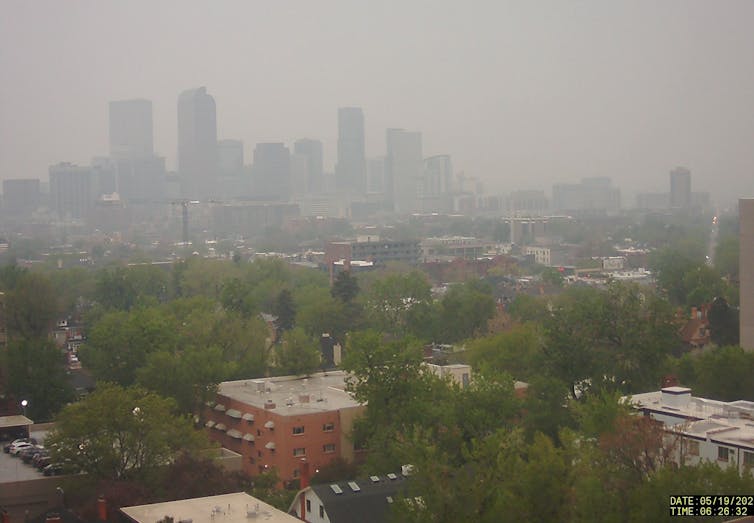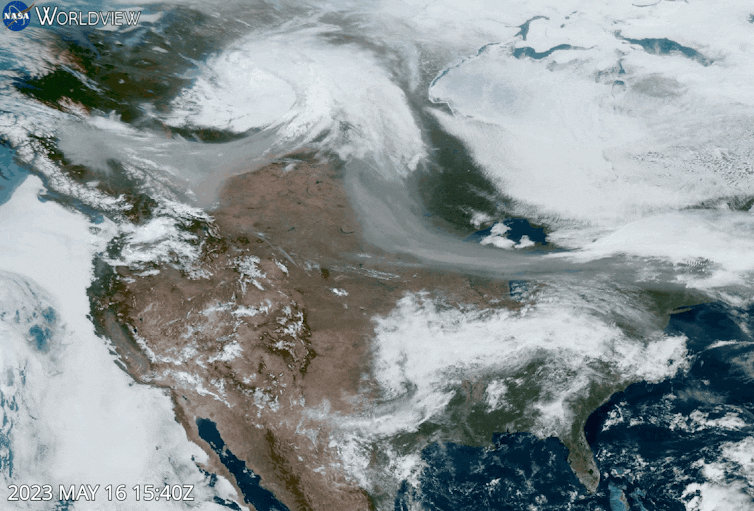Explainer A data-driven story that provides background, definition and detail on a specific topic.
How Wildfire Smoke Impacts Our Health

Smoke from burning across Canada has been rolling into North American cities far from the flames. New York City and Detroit were both listed among the five because of the fires on June 7, 2023. The smoke has triggered air-quality alerts in several states in recent weeks.
We asked , a toxicologist at the University of Montana who studies the impact of wildfire smoke on human health, about the health risks people can face when smoke blows in from distant wildfires.
What’s In Wildfire Smoke That’s a Problem?
When we talk about air quality, we often talk about PM2.5. That’s particulate matter 2.5 microns or smaller—small enough that it can travel deep into the lungs.
Exposure to PM2.5 from smoke or other air pollution, such as vehicle emissions, can exacerbate health conditions like asthma and reduce lung function in ways that can worsen existing respiratory problems and even heart disease.
But the term PM2.5 only tells you about size, not composition—what is burning can make a significant difference in the chemistry.
In the northern Rockies, where I live, most fires are fueled by vegetation, but . If the fire is in the wildland-urban interface, manufactured fuels from homes and vehicles may also be burning, and that’s going to as well. Chemists often talk about (VOCs), carbon monoxide, and PAHs, or , produced when biomass and other matter burns, having the potential to harm human health.
How Does Inhaling Wildfire Smoke Harm Human Health?
If you have ever been around a campfire and gotten a blast of smoke in your face, you probably had some irritation. With exposure to wildfire smoke, you might get some irritation in the nose and throat and maybe . If you’re healthy, your body for the most part will be able to handle it.
As with a lot of things, the dose makes the poison—almost anything can be harmful at a certain dose.
Generally, cells in the lungs called will pick up the particulates and clear them out—at reasonable doses. It’s when the system gets overwhelmed that you can have a problem.

One concern is that smoke can , altering it enough that you become more susceptible to respiratory infection. A colleague who looked at lag time in the effect of wildfire smoke exposure found an . Studies in developing countries have also found increases in with people who are in homes.
The stress of an inflammatory response can also exacerbate existing health problems. Being exposed to woodsmoke won’t independently cause someone to have a heart attack, but if they have underlying risk factors, such as significant plaque buildup, the added stress can increase the risk.
Researchers are also studying potential and from .
When Smoke Blows Over Long Distances, Does Its Toxicity Change?
We know that the chemistry of wildfire smoke changes. The longer it’s in the atmosphere, the more the by ultraviolet light. But we still have .
Researchers have found that there seems to be a higher level of oxidation, so oxidants and free radicals are being generated the longer smoke is in the air. The specific health effects aren’t yet clear, but there’s some indication that more exposure leads to .
The supposition is that more the longer smoke is exposed to UV light, so there’s a greater potential for health harm. A lot of that, again, comes down to dose.

Chances are, if you’re a healthy individual, going for a bike ride or a hike in light haze won’t be a big deal, and your body will be able to recover.
If you’re doing that every day for a month in wildfire smoke, however, that raises more concerns. I’ve worked on studies with residents at Seeley Lake in Montana who were exposed to hazardous levels of PM2.5 from wildfire smoke for 49 days in 2017. We found a . No one was on oxygen, but there was a significant drop.
This is a relatively new area of research, and there’s still a lot we’re learning, especially with the increase in wildfire activity as the planet warms.
What Precautions Can People Take to Reduce Their Risk From Wildfire Smoke?
If there is smoke in the air, you want to decrease your exposure.
Can you completely avoid the smoke? Not unless you’re in a hermetically sealed home. The PM levels aren’t much different indoors and out unless you have a really good HVAC system, such as those with ) . But going inside decreases your activity, so your breathing rate is slower and the amount of smoke you’re inhaling is likely lower.

We also tend to advise people that if you’re in a susceptible group, such as those with asthma, create a safe space at home and in the office with a high-level stand-alone air filtration system to create a space with cleaner air.
Some . It doesn’t hurt to have a high-quality N95 mask. Just wearing a cloth mask won’t do much, though.
Most that can give you a sense of how bad the air quality is, so check those sites and act accordingly.
This article was originally published by . It has been published here with permission.





